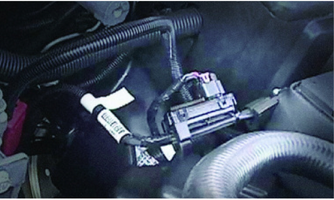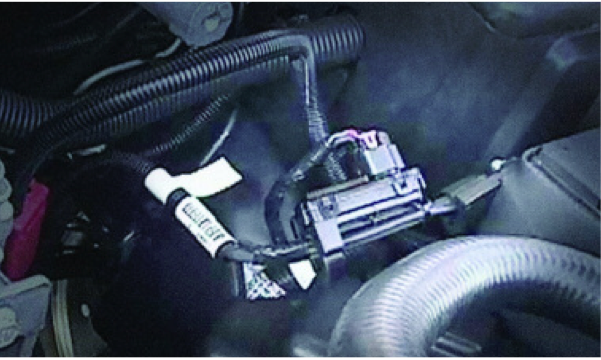Introduction to Battery Control Modules

The module is usually located near the battery on the negative / ground line.
Basic concept and Benefits
Traditional charging systems use an internal temperature sensor inside the generator to establish generator voltage set points. When the generator is cold, it raises the voltage output set point. When the generator is hot, it lowers the voltage output set point. This type of system tends to overcharge the battery on long trips at highway speeds and undercharge the battery on short trips with low vehicle speeds.
Regulated Voltage Control (RVC) is a new dynamic control of the vehicle’s system voltage. It regulates the generator’s output voltage, based mainly on estimated battery temperature and battery state-of- charge. The main benefits of this system are:
• Improved fuel Economy • Extended battery life
• Extended lamp life
• Extended switch life
There are two types of RVC systems used today Integrated RVC and
Stand-alone RVC (SARVC).
Integrated systems use a battery current sensor to provide a body controller (BCM) the amount the battery is charging or discharging. Accurate voltage measurements are taken through the battery positive voltage and ignition 1-voltage circuits. The BCM then communicates information over serial data circuits for the ECM/PCM to directly control the generator.
SARVC systems do not use the BCM for operation. They have a generator battery control module mounted to the negative battery cable, to interpret battery current and voltage, and battery temperature inputs. The battery current sensor is internal to the module. This module also directly controls the generator L-terminal duty cycle instead of the ECM/PCM.
Both types of system have two types of corrective actions to insure the battery stays at 80% state of charge. These include up to three levels of load shed and up to three levels of idle boost operation. Refer to the (GM) service manual Description and Operation for load shed and idle boost.
We will discuss the basic operation of the RVC system, the three different generations of systems used today on GM vehicles, components used on each separate system and general diagnostic information section.
Charge Mode
The control module enters Charge Mode whenever one of the following conditions is met:
• Under WOT conditions and when the fuel rate (sent by the ECM/PCM) is greater than 21 g/s and the throttle position is greater than 90%.
• The headlamps are ON, low or high beam.
• The wipers are ON for more than 8 seconds.
• The electric cooling fans are ON high speed.
• The rear defogger is ON.
• The Battery SOC (state of charge) is less than 80%.
When one of these conditions is met, the control module ramps up the voltage slowly to a level between 13.4 and 15.5 volts (depending upon the mode of operation the system is presently in) at a rate of 8 mV to 50 mV per second.
fuel economy mode
The control module enters Fuel Economy Mode when the following conditions are met:
• The calculated ambient air temperature is above 0°C (32°F).
• The calculated battery current is less than 15 amperes and greater
than -8 amperes.
• The battery state of charge is greater than 80%. • The generator field duty cycle is less than 99%.
Its targeted generator output voltage is 13.0 volts. The control module will exit this mode once the criteria are met for Charge Mode.
components
System Operation
Not all systems will enter all modes of operation; refer to the applicable (GM) service manual for exact Description and Operation.
The purpose of the RVC system is to maintain the battery state-of-charge at 80% or above and support vehicle loads.
The six modes of operation include: Charge Mode
Fuel Economy Mode Voltage Reduction Mode Start Up Mode Windshield Deice Mode Battery Sulfation Mode
The PCM/ECM (generator battery control module on full-size trucks) controls the generator through the generator L-terminal control circuit. It monitors the generator performance through the generator field duty cycle signal circuit. The signal is a 5 volt PWM (pulse width modulated) signal of 128Hz with a duty cycle of 0-100%. Normal duty cycle
is between 5-95%. The ranges between 0-5% and 95-100% are for diagnostic purposes. The following table shows the commanded duty cycle and output voltage of the generator:

Duty Cycle
Generator Voltage set point
10%
11.0V
20%
11.56V
30%
12.12V
40%
12.68V
50%
13.25V
60%
13.81V
70%
14.37V
80%
14.94V
90%
15.5V
The generator provides a feedback signal of the generator load through the generator field duty cycle signal circuit to the control module. The signal is a 5 volt PWM signal of 128 Hz, with a duty cycle if 0-100%. Normal cycle is between 5-99%. The ranges between 0-5% and 100% are for diagnostic purposes.
Voltage Reduction Mode
The control module will enter Voltage Reduction Mode when the following conditions are met:
• The calculated ambient air temperature is above 0°C (32°F).
• The calculated battery current is less than 2 amperes and greater
than -7 amperes.
• The generator field duty cycle is less than 99%.
Its targeted generator output voltage is 12.9 volts. The control module will exit this mode once the criteria are met for Charge Mode.
start up mode
After the engine has started, the control module sets a targeted generator output voltage of 14.5 volts for 30 seconds.
Battery sulfation mode
The control module enters this mode when the battery voltage is less than 13.2 volts for 45 minutes. Once in this mode, the generator battery control module will set a targeted output voltage between 13.9 to 15.5 volts for 5 minutes. The control module will then determine which mode to enter depending on voltage requirements.
RVC Mode
The control module bases the charging voltage on battery state of charge (SOC). Battery SOC is estimated during a key off event every 8 hours, after 3 voltage measurements every 24 hours thereafter, and then monitored constantly while the ignition is on. These measurements of voltage are then compared to estimated battery temperature, as battery temperature vs. battery voltage directly corresponds to battery SOC. While the engine is running, the system uses both the battery voltage and estimated battery temperature to determine the battery current in and out of the battery. The control module then regulates the charging voltage to keep the battery above an 80% SOC.


 )
)
